Target Information
| Target General Information | Top | |||||
|---|---|---|---|---|---|---|
| Target ID |
T22285
(Former ID: TTDS00123)
|
|||||
| Target Name |
Glutamate receptor ionotropic NMDA 2A (NMDAR2A)
|
|||||
| Synonyms |
NR2A; NMDA receptor NR2A; N-methyl D-aspartate receptor subtype 2A; HNR2A; Glutamate receptor ionotropic, NMDA 2A; Glutamate [NMDA] receptor subunit epsilon-1; GluN2A
Click to Show/Hide
|
|||||
| Gene Name |
GRIN2A
|
|||||
| Target Type |
Successful target
|
[1] | ||||
| Disease | [+] 1 Target-related Diseases | + | ||||
| 1 | Nutritional deficiency [ICD-11: 5B50-5B71] | |||||
| Function |
Channel activation requires binding of the neurotransmitter glutamate to the epsilon subunit, glycine binding to the zeta subunit, plus membrane depolarization to eliminate channel inhibition by Mg(2+). Sensitivity to glutamate and channel kinetics depend on the subunit composition; channels containing GRIN1 and GRIN2A have higher sensitivity to glutamate and faster kinetics than channels formed by GRIN1 and GRIN2B. Contributes to the slow phase of excitatory postsynaptic current, long-term synaptic potentiation, and learning. Component of NMDA receptor complexes that function as heterotetrameric, ligand-gated ion channels with high calcium permeability and voltage-dependent sensitivity to magnesium.
Click to Show/Hide
|
|||||
| BioChemical Class |
Glutamate-gated ion channel
|
|||||
| UniProt ID | ||||||
| Sequence |
MGRVGYWTLLVLPALLVWRGPAPSAAAEKGPPALNIAVMLGHSHDVTERELRTLWGPEQA
AGLPLDVNVVALLMNRTDPKSLITHVCDLMSGARIHGLVFGDDTDQEAVAQMLDFISSHT FVPILGIHGGASMIMADKDPTSTFFQFGASIQQQATVMLKIMQDYDWHVFSLVTTIFPGY REFISFVKTTVDNSFVGWDMQNVITLDTSFEDAKTQVQLKKIHSSVILLYCSKDEAVLIL SEARSLGLTGYDFFWIVPSLVSGNTELIPKEFPSGLISVSYDDWDYSLEARVRDGIGILT TAASSMLEKFSYIPEAKASCYGQMERPEVPMHTLHPFMVNVTWDGKDLSFTEEGYQVHPR LVVIVLNKDREWEKVGKWENHTLSLRHAVWPRYKSFSDCEPDDNHLSIVTLEEAPFVIVE DIDPLTETCVRNTVPCRKFVKINNSTNEGMNVKKCCKGFCIDILKKLSRTVKFTYDLYLV TNGKHGKKVNNVWNGMIGEVVYQRAVMAVGSLTINEERSEVVDFSVPFVETGISVMVSRS NGTVSPSAFLEPFSASVWVMMFVMLLIVSAIAVFVFEYFSPVGYNRNLAKGKAPHGPSFT IGKAIWLLWGLVFNNSVPVQNPKGTTSKIMVSVWAFFAVIFLASYTANLAAFMIQEEFVD QVTGLSDKKFQRPHDYSPPFRFGTVPNGSTERNIRNNYPYMHQYMTKFNQKGVEDALVSL KTGKLDAFIYDAAVLNYKAGRDEGCKLVTIGSGYIFATTGYGIALQKGSPWKRQIDLALL QFVGDGEMEELETLWLTGICHNEKNEVMSSQLDIDNMAGVFYMLAAAMALSLITFIWEHL FYWKLRFCFTGVCSDRPGLLFSISRGIYSCIHGVHIEEKKKSPDFNLTGSQSNMLKLLRS AKNISSMSNMNSSRMDSPKRAADFIQRGSLIMDMVSDKGNLMYSDNRSFQGKESIFGDNM NELQTFVANRQKDNLNNYVFQGQHPLTLNESNPNTVEVAVSTESKANSRPRQLWKKSVDS IRQDSLSQNPVSQRDEATAENRTHSLKSPRYLPEEMAHSDISETSNRATCHREPDNSKNH KTKDNFKRSVASKYPKDCSEVERTYLKTKSSSPRDKIYTIDGEKEPGFHLDPPQFVENVT LPENVDFPDPYQDPSENFRKGDSTLPMNRNPLHNEEGLSNNDQYKLYSKHFTLKDKGSPH SETSERYRQNSTHCRSCLSNMPTYSGHFTMRSPFKCDACLRMGNLYDIDEDQMLQETGNP ATGEQVYQQDWAQNNALQLQKNKLRISRQHSYDNIVDKPRELDLSRPSRSISLKDRERLL EGNFYGSLFSVPSSKLSGKKSSLFPQGLEDSKRSKSLLPDHTSDNPFLHSHRDDQRLVIG RCPSDPYKHSLPSQAVNDSYLRSSLRSTASYCSRDSRGHNDVYISEHVMPYAANKNNMYS TPRVLNSCSNRRVYKKMPSIESDV Click to Show/Hide
|
|||||
| 3D Structure | Click to Show 3D Structure of This Target | AlphaFold | ||||
| HIT2.0 ID | T74SS7 | |||||
| Drugs and Modes of Action | Top | |||||
|---|---|---|---|---|---|---|
| Approved Drug(s) | [+] 1 Approved Drugs | + | ||||
| 1 | Glycine | Drug Info | Approved | Malnutrition | [2], [3] | |
| Clinical Trial Drug(s) | [+] 1 Clinical Trial Drugs | + | ||||
| 1 | NBQX | Drug Info | Phase 1 | Neurological disorder | [4] | |
| Discontinued Drug(s) | [+] 6 Discontinued Drugs | + | ||||
| 1 | YM-90K | Drug Info | Discontinued in Phase 2 | Convulsion | [5] | |
| 2 | DIZOCILPINE | Drug Info | Terminated | Cerebrovascular ischaemia | [6], [7] | |
| 3 | L-689560 | Drug Info | Terminated | Neurodegenerative disorder | [8], [9] | |
| 4 | L-698532 | Drug Info | Terminated | Neurological disorder | [10] | |
| 5 | L-698544 | Drug Info | Terminated | Alzheimer disease | [11] | |
| 6 | L-701324 | Drug Info | Terminated | Cerebrovascular ischaemia | [12], [13], [14] | |
| Mode of Action | [+] 5 Modes of Action | + | ||||
| Antagonist | [+] 14 Antagonist drugs | + | ||||
| 1 | Glycine | Drug Info | [1] | |||
| 2 | L-689560 | Drug Info | [18] | |||
| 3 | CGP61594 | Drug Info | [18] | |||
| 4 | d-AP5 | Drug Info | [18] | |||
| 5 | d-CCPene | Drug Info | [18] | |||
| 6 | LY233053 | Drug Info | [18] | |||
| 7 | MDL 100,453 | Drug Info | [37] | |||
| 8 | NVP-AAM077 | Drug Info | [39] | |||
| 9 | Tenocyclidine | Drug Info | [42] | |||
| 10 | UBP141 | Drug Info | [24] | |||
| 11 | [3H]CGP39653 | Drug Info | [18] | |||
| 12 | [3H]CGS19755 | Drug Info | [18] | |||
| 13 | [3H]CPP | Drug Info | [18] | |||
| 14 | [3H]MDL105519 | Drug Info | [18] | |||
| Inhibitor | [+] 57 Inhibitor drugs | + | ||||
| 1 | NBQX | Drug Info | [15] | |||
| 2 | YM-90K | Drug Info | [16] | |||
| 3 | DIZOCILPINE | Drug Info | [17] | |||
| 4 | L-695902 | Drug Info | [19] | |||
| 5 | L-698532 | Drug Info | [20] | |||
| 6 | L-698544 | Drug Info | [19] | |||
| 7 | L-701324 | Drug Info | [20] | |||
| 8 | RPR-104632 | Drug Info | [21] | |||
| 9 | SPERMINE | Drug Info | [22] | |||
| 10 | (D)-Ala-Pro-Glu | Drug Info | [23] | |||
| 11 | (R)-2-Amino-5-phosphono-pentanoic acid | Drug Info | [24] | |||
| 12 | (R)-2-Amino-7-phosphono-heptanoic acid | Drug Info | [24] | |||
| 13 | 1,3-ditolylguanidine | Drug Info | [25] | |||
| 14 | 2-Methylamino-succinic acid(NMDA) | Drug Info | [18], [26] | |||
| 15 | 3-Benzoyl-7-chloro-4-hydroxy-1H-quinolin-2-one | Drug Info | [19] | |||
| 16 | 3-Hydroxy-1H-benzo[b]azepine-2,5-dione | Drug Info | [27] | |||
| 17 | 3-Hydroxy-6-methyl-1H-benzo[b]azepine-2,5-dione | Drug Info | [27] | |||
| 18 | 3-Hydroxy-7-nitro-1H-benzo[b]azepine-2,5-dione | Drug Info | [27] | |||
| 19 | 3-Hydroxy-8-methyl-1H-benzo[b]azepine-2,5-dione | Drug Info | [27] | |||
| 20 | 4,5,7-Trichloro-3-hydroxy-1H-quinolin-2-one | Drug Info | [28] | |||
| 21 | 4,6-Dichloro-1H-indole-2-carboxylic acid | Drug Info | [29] | |||
| 22 | 4-Bromo-3-hydroxy-1H-quinolin-2-one | Drug Info | [28] | |||
| 23 | 4-Bromo-5,7-dichloro-3-hydroxy-1H-quinolin-2-one | Drug Info | [28] | |||
| 24 | 4-Chloro-3-hydroxy-1H-quinolin-2-one | Drug Info | [28] | |||
| 25 | 4-hydroxy-5-phenylthieno[2,3-b]pyridin-6(7H)-one | Drug Info | [20] | |||
| 26 | 4-[2-(5-Phenyl-pentylamino)-ethyl]-phenol | Drug Info | [30] | |||
| 27 | 4-[2-(6-Phenyl-hexylamino)-ethyl]-phenol | Drug Info | [30] | |||
| 28 | 4-[3-(4-Phenyl-butylamino)-propyl]-phenol | Drug Info | [30] | |||
| 29 | 4-[3-(5-Phenyl-pentylamino)-propyl]-phenol | Drug Info | [30] | |||
| 30 | 5,7-Dichloro-3-hydroxy-1H-quinazoline-2,4-dione | Drug Info | [31] | |||
| 31 | 5,7-Dichloro-4-hydroxy-3-phenyl-1H-quinolin-2-one | Drug Info | [19] | |||
| 32 | 5,7-Dinitro-1,4-dihydro-quinoxaline-2,3-dione | Drug Info | [19] | |||
| 33 | 6,7-Dichloro-3-hydroxy-1H-quinazoline-2,4-dione | Drug Info | [31] | |||
| 34 | 6-Chloro-1,4-dihydro-quinoxaline-2,3-dione | Drug Info | [32] | |||
| 35 | 6-Nitro-1,4-dihydro-quinoxaline-2,3-dione | Drug Info | [32] | |||
| 36 | 7-chloro-3-hydroxyquinazoline-2,4-dione | Drug Info | [33] | |||
| 37 | 8-Bromo-3-hydroxy-1H-benzo[b]azepine-2,5-dione | Drug Info | [27] | |||
| 38 | 8-Ethyl-3-hydroxy-1H-benzo[b]azepine-2,5-dione | Drug Info | [27] | |||
| 39 | 8-Fluoro-3-hydroxy-1H-benzo[b]azepine-2,5-dione | Drug Info | [27] | |||
| 40 | Ala-Pro-Glu | Drug Info | [23] | |||
| 41 | AP-7 | Drug Info | [34] | |||
| 42 | DNQX | Drug Info | [35] | |||
| 43 | Gly-Amp-Glu | Drug Info | [23] | |||
| 44 | Gly-Hyp-Glu | Drug Info | [23] | |||
| 45 | Gly-Pip-Glu | Drug Info | [23] | |||
| 46 | H-Gly-D-dmP-Glu-OH | Drug Info | [36] | |||
| 47 | H-Gly-dmP-Glu-OH | Drug Info | [36] | |||
| 48 | N,N'-Bis-(4-butoxy-phenyl)-guanidine | Drug Info | [25] | |||
| 49 | N,N'-Bis-(4-butyl-phenyl)-guanidine | Drug Info | [25] | |||
| 50 | N,N'-Bis-(4-ethyl-phenyl)-guanidine | Drug Info | [25] | |||
| 51 | N,N'-Bis-(4-isopropyl-phenyl)-guanidine | Drug Info | [25] | |||
| 52 | N-(2-methoxybenzyl)cinnamamidine | Drug Info | [38] | |||
| 53 | Nle-Pro-Glu | Drug Info | [23] | |||
| 54 | Phe-Pro-Glu | Drug Info | [23] | |||
| 55 | PHENCYCLIDINE | Drug Info | [40] | |||
| 56 | RPR-118723 | Drug Info | [21] | |||
| 57 | TRANSTORINE | Drug Info | [29] | |||
| Agonist | [+] 5 Agonist drugs | + | ||||
| 1 | (+)-HA966 | Drug Info | [18] | |||
| 2 | (RS)-(tetrazol-5-yl)glycine | Drug Info | [18] | |||
| 3 | D-aspartic acid | Drug Info | [18] | |||
| 4 | homoquinolinic acid | Drug Info | [18] | |||
| 5 | L-aspartic acid | Drug Info | [18] | |||
| Blocker (channel blocker) | [+] 2 Blocker (channel blocker) drugs | + | ||||
| 1 | N1-dansyl-spermine | Drug Info | [18] | |||
| 2 | [3H]dizocilpine | Drug Info | [18] | |||
| Modulator (allosteric modulator) | [+] 1 Modulator (allosteric modulator) drugs | + | ||||
| 1 | TCN-201 | Drug Info | [41] | |||
| Cell-based Target Expression Variations | Top | |||||
|---|---|---|---|---|---|---|
| Cell-based Target Expression Variations | ||||||
| Drug Binding Sites of Target | Top | |||||
|---|---|---|---|---|---|---|
| Ligand Name: (2R)-4-(3-phosphonopropyl)piperazine-2-carboxylic acid | Ligand Info | |||||
| Structure Description | Structure of the human GluN1/GluN2A NMDA receptor in the glycine/CPP bound state | PDB:7EOQ | ||||
| Method | Electron microscopy | Resolution | 4.10 Å | Mutation | Yes | [43] |
| PDB Sequence |
LNIAVMLGHS
43 HDVTERELRT53 LWGPEQAAGL63 PLDVNVVALL73 MNRTDPKSLI83 THVCDLMSGA 93 RIHGLVFGDD103 TDQEAVAQML113 DFISSHTFVP123 ILGIHGGASM133 IMADKDPTST 143 FFQFGASIQQ153 QATVMLKIMQ163 DYDWHVFSLV173 TTIFPGYREF183 ISFVKTTVDN 193 SFVGWDMQNV203 ITLDTSFEDA213 KTQVQLKKIH223 SSVILLYCSK233 DEAVLILSEA 243 RSLGLTGYDF253 FWIVPSLVSG263 NTELIPKEFP273 SGLISVSYDD283 WDYSLEARVR 293 DGIGILTTAA303 SSMLEKFSYI313 PEAKASCYGQ323 MERPEVPMHT333 LHPFMVNVTW 343 DGKDLSFTEE353 GYQVHPRLVV363 IVLNKDREWE373 KVGKWENHTL383 SLRHAVWPRY 393 KSFSDCEPDD403 NHLSIVTLEE413 APFVIVEDID423 PLTETCVRNT433 VPCRKFVKIN 443 NSTNEGMNVK453 KCCKGFCIDI463 LKKLSRTVKF473 TYDLYLVTNG483 KHGKKVNNVW 493 NGMIGEVVYQ503 RAVMAVGSLT513 INEERSEVVD523 FSVPFVETGI533 SVMVSRSNGT 543 VSPSAFLEPF553 SASVWVMMFV563 MLLIVSAIAV573 FVFEYFSPSF599 TIGKAIWLLW 609 GLVFNNSVPV619 QNPKGTTSKI629 MVSVWAFFAV639 IFLASYTANL649 AAFMIQFVDQ 661 VTGLSDKKFQ671 RPHDYSPPFR681 FGTVPNGSTE691 RNIRNNYPYM701 HQYMTKFNQK 711 GVEDALVSLK721 TGKLDAFIYD731 AAVLNYKAGR741 DEGCKLVTIG751 SGYIFATTGY 761 GIALQKGSPW771 KRQIDLALLQ781 FVGDGEMEEL791 ETCWLTGICH801 NEVMSSQLDI 814 DNMAGVFYML824 AAAMALSLIT834 FIW
|
|||||
|
|
||||||
| Ligand Name: 6-[[ethyl-(4-Fluorophenyl)amino]methyl]-2,3-Dihydro-1~{h}-Cyclopenta[3,4][1,3]thiazolo[1,4-~{a}]pyrimidin-8-One | Ligand Info | |||||
| Structure Description | Structure of the human GluN1/GluN2A LBD in complex with GNE8324 | PDB:5H8Q | ||||
| Method | X-ray diffraction | Resolution | 1.90 Å | Mutation | No | [44] |
| PDB Sequence |
NHLSIVTLEE
15 APFVIVEDID25 PETCVRNTVP37 CRKFVKINNS47 TNEGMNVKKC57 CKGFCIDILK 67 KLSRTVKFTY77 DLYLVTNGKH87 GKKVNNVWNG97 MIGEVVYQRA107 VMAVGSLTIN 117 EERSEVVDFS127 VPFVETGISV137 MVSRGTQVTG147 LSDKKFQRPH157 DYSPPFRFGT 167 VPNGSTERNI177 RNNYPYMHQY187 MTKFNQKGVE197 DALVSLKTGK207 LDAFIYDAAV 217 LNYKAGRDEG227 CKLVTIGSGY237 IFATTGYGIA247 LQKGSPWKRQ257 IDLALLQFVG 267 DGEMEELETL277 WLTGIC
|
|||||
|
|
||||||
| Click to View More Binding Site Information of This Target with Different Ligands | ||||||
| Different Human System Profiles of Target | Top |
|---|---|
|
Human Similarity Proteins
of target is determined by comparing the sequence similarity of all human proteins with the target based on BLAST. The similarity proteins for a target are defined as the proteins with E-value < 0.005 and outside the protein families of the target.
A target that has fewer human similarity proteins outside its family is commonly regarded to possess a greater capacity to avoid undesired interactions and thus increase the possibility of finding successful drugs
(Brief Bioinform, 21: 649-662, 2020).
Human Tissue Distribution
of target is determined from a proteomics study that quantified more than 12,000 genes across 32 normal human tissues. Tissue Specificity (TS) score was used to define the enrichment of target across tissues.
The distribution of targets among different tissues or organs need to be taken into consideration when assessing the target druggability, as it is generally accepted that the wider the target distribution, the greater the concern over potential adverse effects
(Nat Rev Drug Discov, 20: 64-81, 2021).
Human Pathway Affiliation
of target is determined by the life-essential pathways provided on KEGG database. The target-affiliated pathways were defined based on the following two criteria (a) the pathways of the studied target should be life-essential for both healthy individuals and patients, and (b) the studied target should occupy an upstream position in the pathways and therefore had the ability to regulate biological function.
Targets involved in a fewer pathways have greater likelihood to be successfully developed, while those associated with more human pathways increase the chance of undesirable interferences with other human processes
(Pharmacol Rev, 58: 259-279, 2006).
Biological Network Descriptors
of target is determined based on a human protein-protein interactions (PPI) network consisting of 9,309 proteins and 52,713 PPIs, which were with a high confidence score of ≥ 0.95 collected from STRING database.
The network properties of targets based on protein-protein interactions (PPIs) have been widely adopted for the assessment of target’s druggability. Proteins with high node degree tend to have a high impact on network function through multiple interactions, while proteins with high betweenness centrality are regarded to be central for communication in interaction networks and regulate the flow of signaling information
(Front Pharmacol, 9, 1245, 2018;
Curr Opin Struct Biol. 44:134-142, 2017).
Human Similarity Proteins
Human Tissue Distribution
Human Pathway Affiliation
Biological Network Descriptors
|
|
|
There is no similarity protein (E value < 0.005) for this target
|
|
Note:
If a protein has TS (tissue specficity) scores at least in one tissue >= 2.5, this protein is called tissue-enriched (including tissue-enriched-but-not-specific and tissue-specific). In the plots, the vertical lines are at thresholds 2.5 and 4.
|
| KEGG Pathway | Pathway ID | Affiliated Target | Pathway Map |
|---|---|---|---|
| Ras signaling pathway | hsa04014 | Affiliated Target |
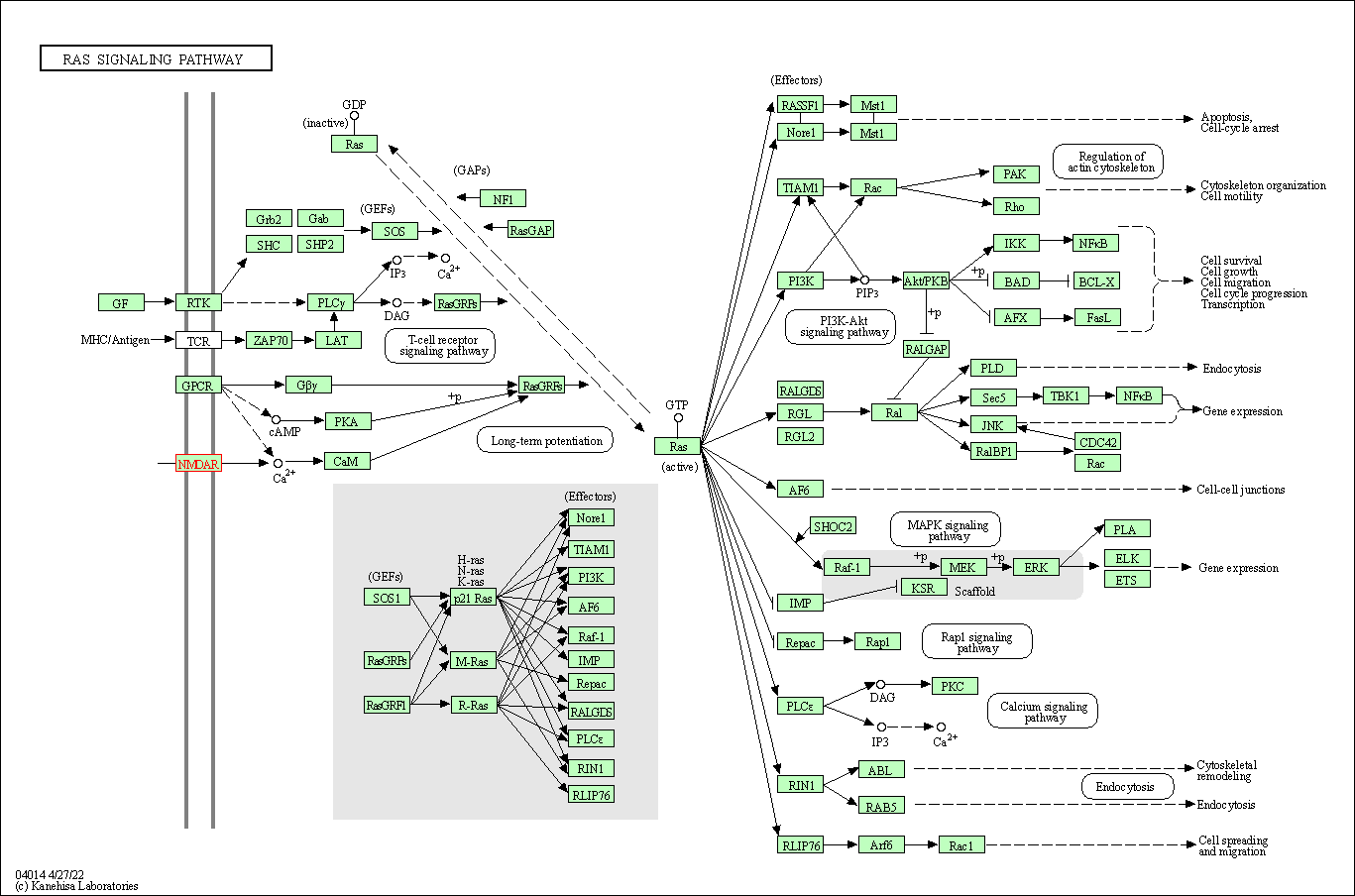
|
| Class: Environmental Information Processing => Signal transduction | Pathway Hierarchy | ||
| Rap1 signaling pathway | hsa04015 | Affiliated Target |
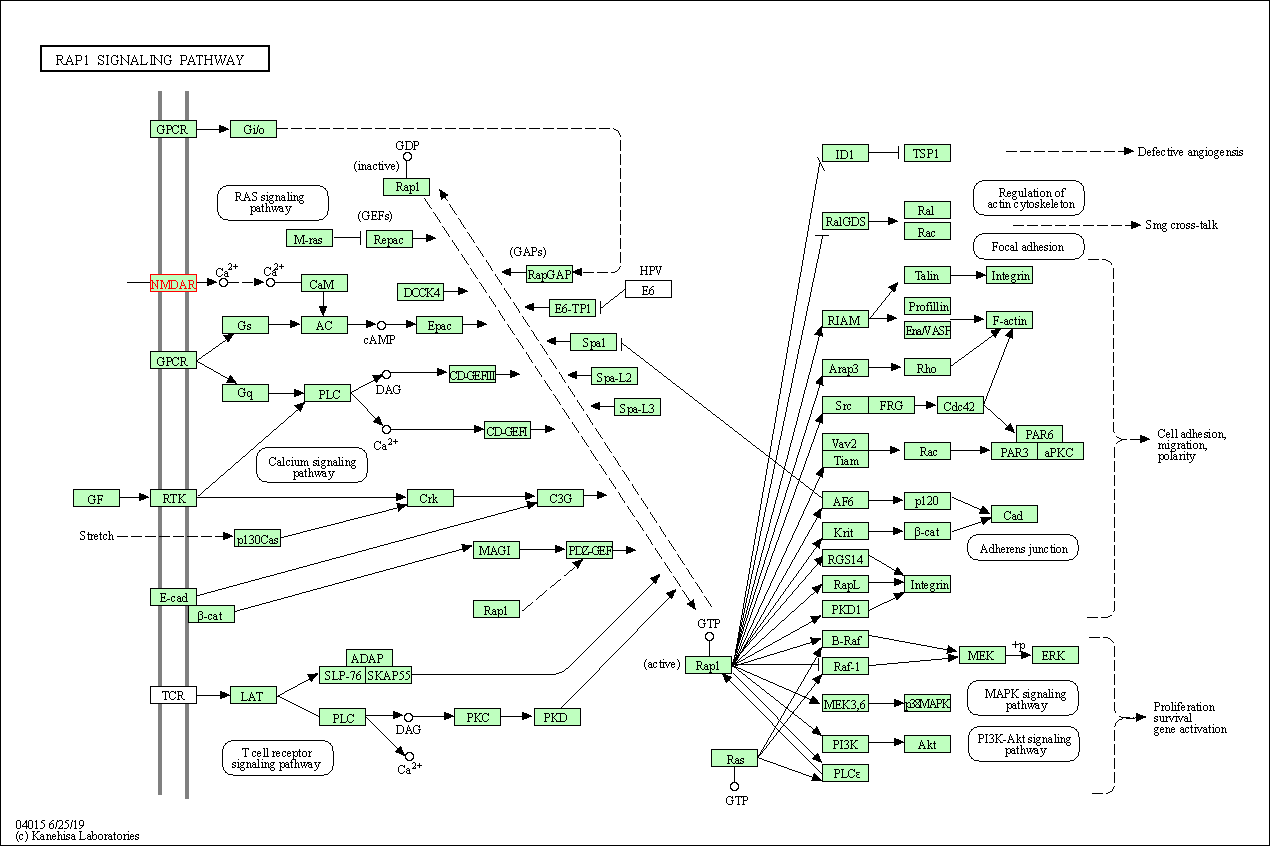
|
| Class: Environmental Information Processing => Signal transduction | Pathway Hierarchy | ||
| Calcium signaling pathway | hsa04020 | Affiliated Target |

|
| Class: Environmental Information Processing => Signal transduction | Pathway Hierarchy | ||
| cAMP signaling pathway | hsa04024 | Affiliated Target |

|
| Class: Environmental Information Processing => Signal transduction | Pathway Hierarchy | ||
| Neuroactive ligand-receptor interaction | hsa04080 | Affiliated Target |
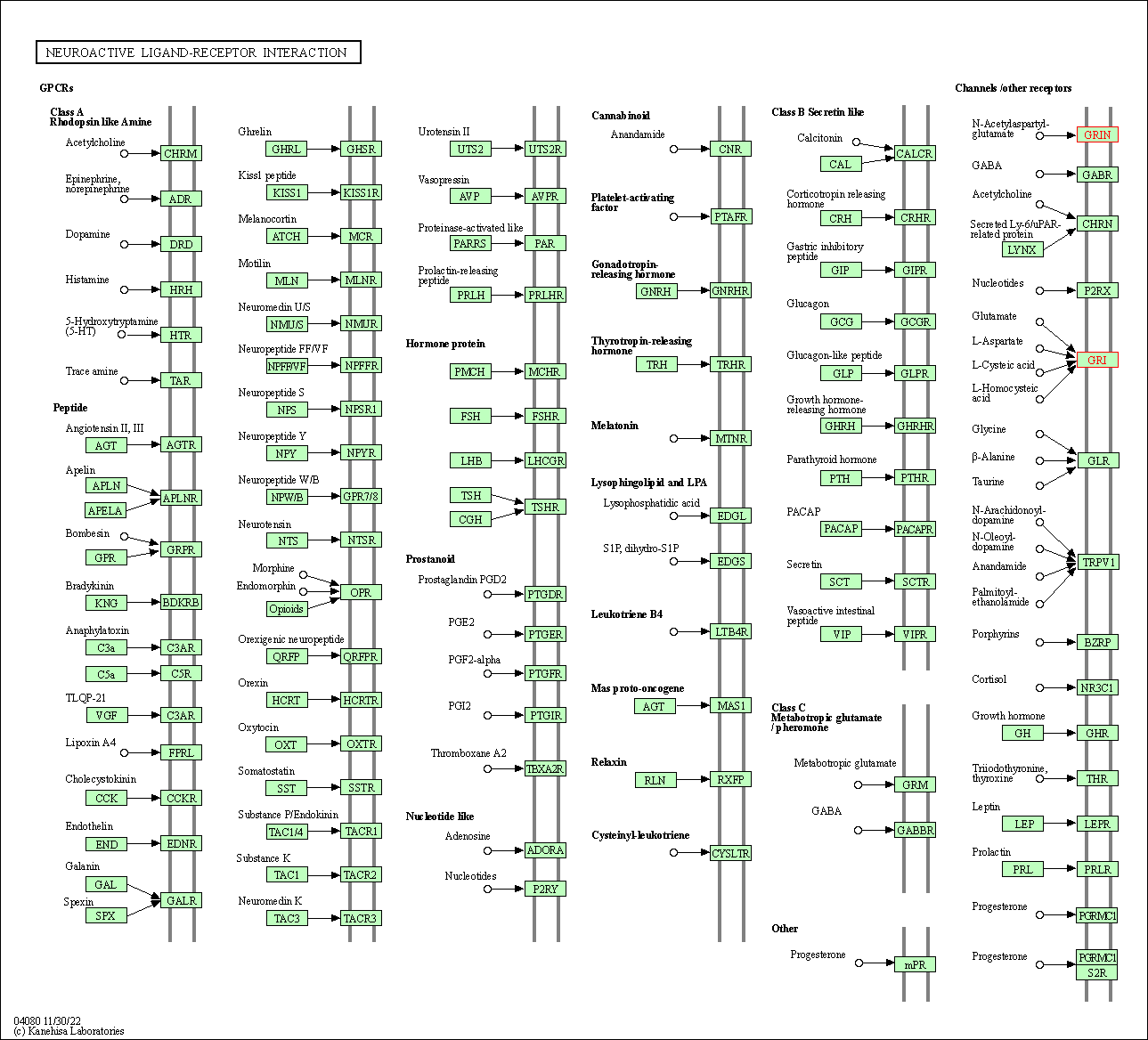
|
| Class: Environmental Information Processing => Signaling molecules and interaction | Pathway Hierarchy | ||
| Circadian entrainment | hsa04713 | Affiliated Target |
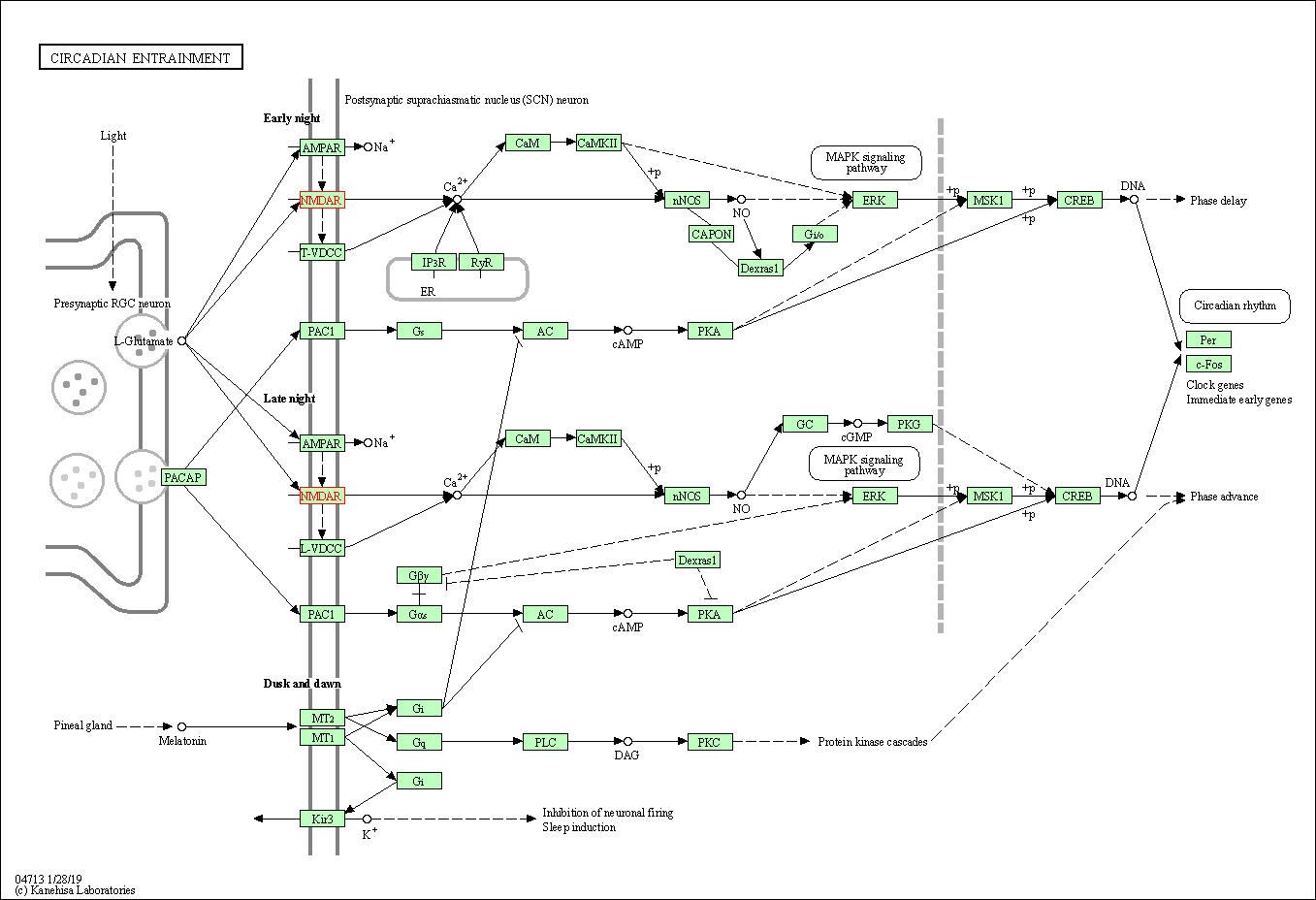
|
| Class: Organismal Systems => Environmental adaptation | Pathway Hierarchy | ||
| Long-term potentiation | hsa04720 | Affiliated Target |

|
| Class: Organismal Systems => Nervous system | Pathway Hierarchy | ||
| Glutamatergic synapse | hsa04724 | Affiliated Target |
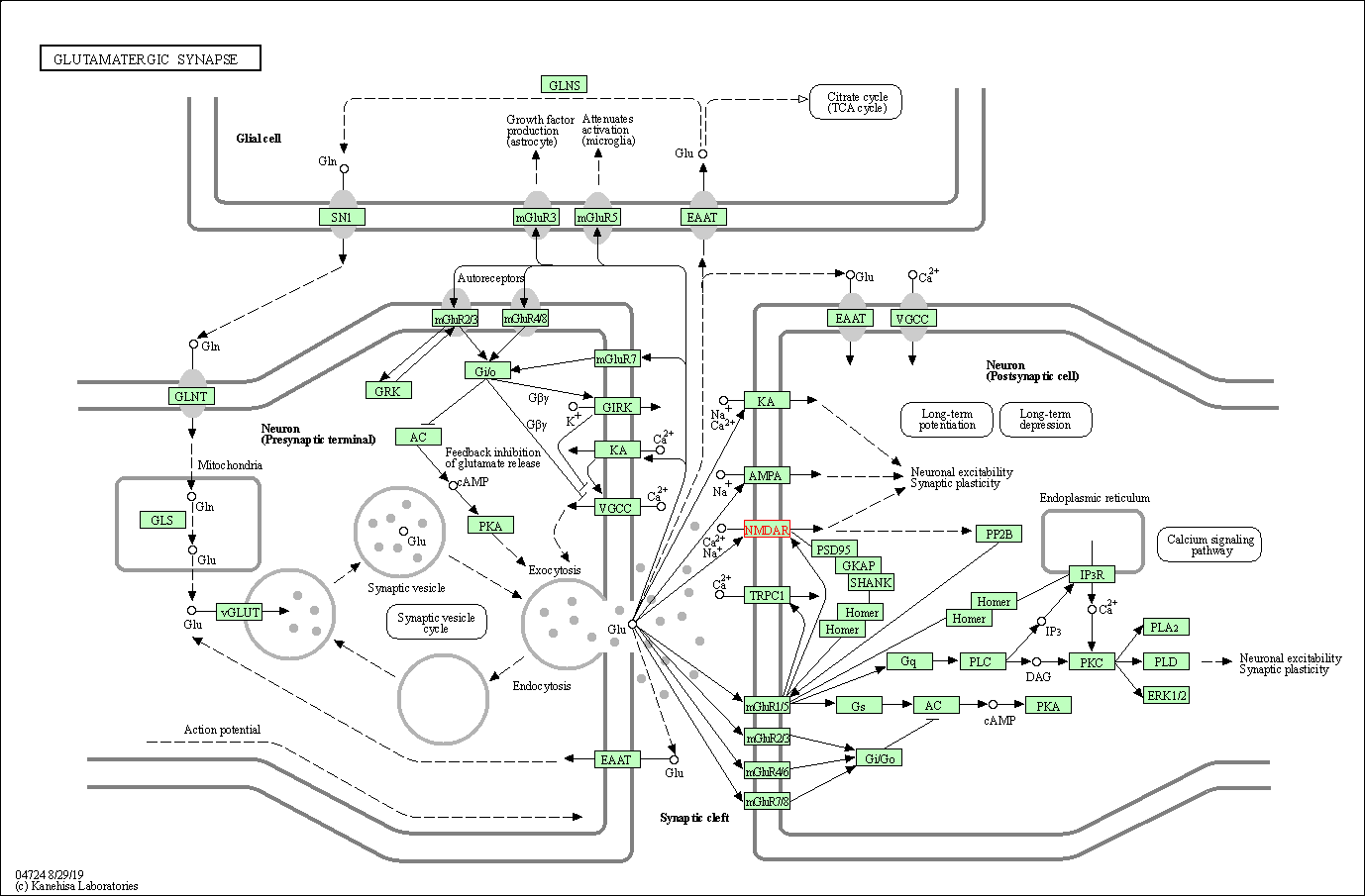
|
| Class: Organismal Systems => Nervous system | Pathway Hierarchy | ||
| Dopaminergic synapse | hsa04728 | Affiliated Target |
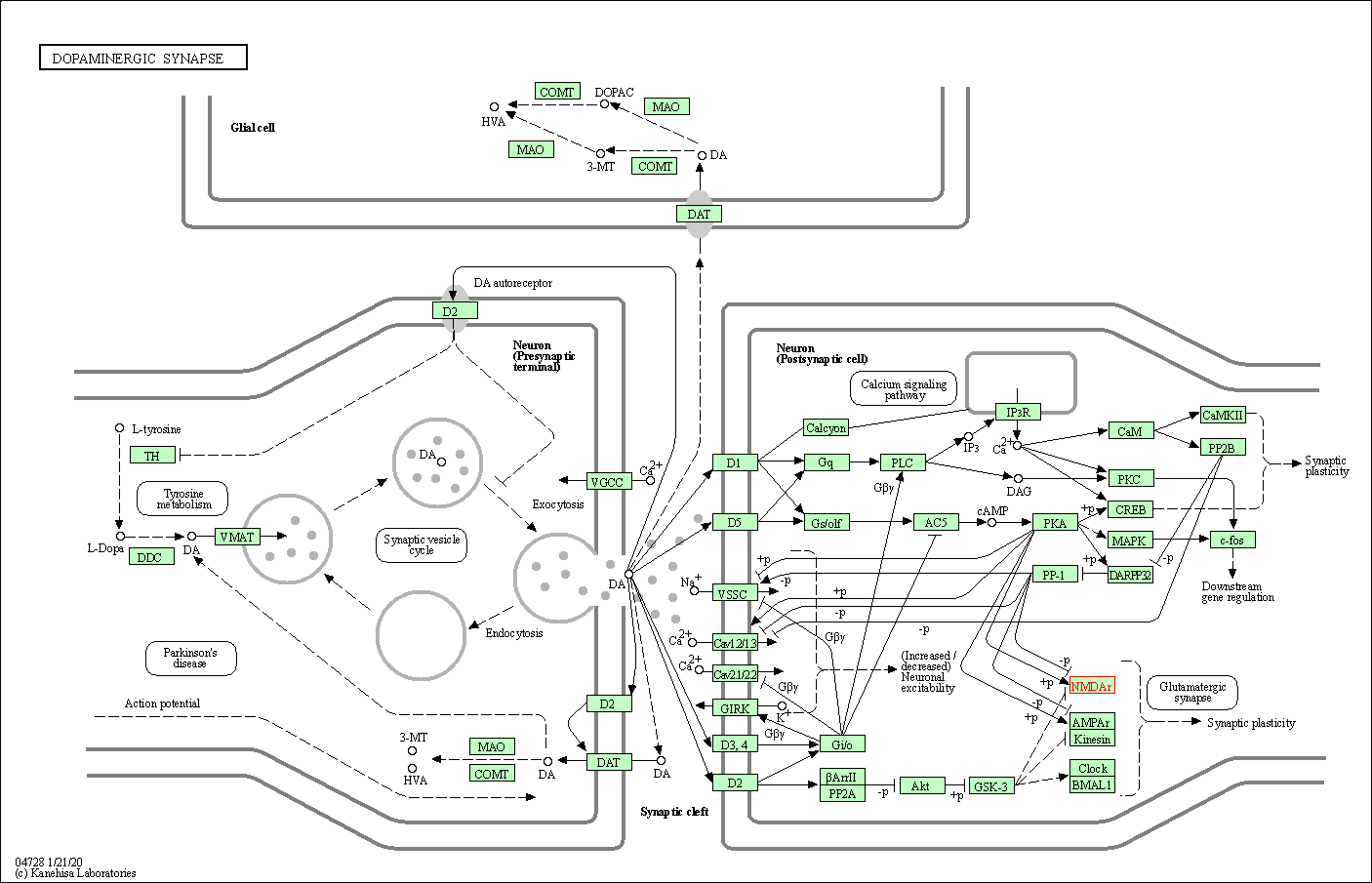
|
| Class: Organismal Systems => Nervous system | Pathway Hierarchy | ||
| Click to Show/Hide the Information of Affiliated Human Pathways | |||
| Degree | 14 | Degree centrality | 1.50E-03 | Betweenness centrality | 3.31E-04 |
|---|---|---|---|---|---|
| Closeness centrality | 2.31E-01 | Radiality | 1.41E+01 | Clustering coefficient | 2.86E-01 |
| Neighborhood connectivity | 3.56E+01 | Topological coefficient | 1.07E-01 | Eccentricity | 12 |
| Download | Click to Download the Full PPI Network of This Target | ||||
| Chemical Structure based Activity Landscape of Target | Top |
|---|---|
| Drug Property Profile of Target | Top | |
|---|---|---|
| (1) Molecular Weight (mw) based Drug Clustering | (2) Octanol/Water Partition Coefficient (xlogp) based Drug Clustering | |
|
|
||
| (3) Hydrogen Bond Donor Count (hbonddonor) based Drug Clustering | (4) Hydrogen Bond Acceptor Count (hbondacc) based Drug Clustering | |
|
|
||
| (5) Rotatable Bond Count (rotbonds) based Drug Clustering | (6) Topological Polar Surface Area (polararea) based Drug Clustering | |
|
|
||
| "RO5" indicates the cutoff set by lipinski's rule of five; "D123AB" colored in GREEN denotes the no violation of any cutoff in lipinski's rule of five; "D123AB" colored in PURPLE refers to the violation of only one cutoff in lipinski's rule of five; "D123AB" colored in BLACK represents the violation of more than one cutoffs in lipinski's rule of five | ||
| Co-Targets | Top | |||||
|---|---|---|---|---|---|---|
| Co-Targets | ||||||
| Target Poor or Non Binders | Top | |||||
|---|---|---|---|---|---|---|
| Target Poor or Non Binders | ||||||
| Target Regulators | Top | |||||
|---|---|---|---|---|---|---|
| Target-interacting Proteins | ||||||
| Target Profiles in Patients | Top | |||||
|---|---|---|---|---|---|---|
| Target Expression Profile (TEP) | ||||||
| Target-Related Models and Studies | Top | |||||
|---|---|---|---|---|---|---|
| Target Validation | ||||||
| References | Top | |||||
|---|---|---|---|---|---|---|
| REF 1 | Glycine transport inhibitors for the treatment of schizophrenia: Symptom and disease modification. Curr Opin Drug Discov Devel. 2009 Jul;12(4):468-78. | |||||
| REF 2 | URL: http://www.guidetopharmacology.org Nucleic Acids Res. 2015 Oct 12. pii: gkv1037. The IUPHAR/BPS Guide to PHARMACOLOGY in 2016: towards curated quantitative interactions between 1300 protein targets and 6000 ligands. (Ligand id: 727). | |||||
| REF 3 | FDA Approved Drug Products from FDA Official Website. 2009. Application Number: (NDA) 016784. | |||||
| REF 4 | URL: http://www.guidetopharmacology.org Nucleic Acids Res. 2015 Oct 12. pii: gkv1037. The IUPHAR/BPS Guide to PHARMACOLOGY in 2016: towards curated quantitative interactions between 1300 protein targets and 6000 ligands. (Ligand id: 4264). | |||||
| REF 5 | Trusted, scientifically sound profiles of drug programs, clinical trials, safety reports, and company deals, written by scientists. Springer. 2015. Adis Insight (drug id 800002155) | |||||
| REF 6 | URL: http://www.guidetopharmacology.org Nucleic Acids Res. 2015 Oct 12. pii: gkv1037. The IUPHAR/BPS Guide to PHARMACOLOGY in 2016: towards curated quantitative interactions between 1300 protein targets and 6000 ligands. (Ligand id: 2403). | |||||
| REF 7 | Trusted, scientifically sound profiles of drug programs, clinical trials, safety reports, and company deals, written by scientists. Springer. 2015. Adis Insight (drug id 800000713) | |||||
| REF 8 | URL: http://www.guidetopharmacology.org Nucleic Acids Res. 2015 Oct 12. pii: gkv1037. The IUPHAR/BPS Guide to PHARMACOLOGY in 2016: towards curated quantitative interactions between 1300 protein targets and 6000 ligands. (Ligand id: 4239). | |||||
| REF 9 | Trusted, scientifically sound profiles of drug programs, clinical trials, safety reports, and company deals, written by scientists. Springer. 2015. Adis Insight (drug id 800001828) | |||||
| REF 10 | Trusted, scientifically sound profiles of drug programs, clinical trials, safety reports, and company deals, written by scientists. Springer. 2015. Adis Insight (drug id 800006620) | |||||
| REF 11 | Trusted, scientifically sound profiles of drug programs, clinical trials, safety reports, and company deals, written by scientists. Springer. 2015. Adis Insight (drug id 800003218) | |||||
| REF 12 | URL: http://www.guidetopharmacology.org Nucleic Acids Res. 2015 Oct 12. pii: gkv1037. The IUPHAR/BPS Guide to PHARMACOLOGY in 2016: towards curated quantitative interactions between 1300 protein targets and 6000 ligands. (Ligand id: 4240). | |||||
| REF 13 | Anticonvulsant and behavioral profile of L-701,324, a potent, orally active antagonist at the glycine modulatory site on the N-methyl-D-aspartate receptor complex. J Pharmacol Exp Ther. 1996 Nov;279(2):492-501. | |||||
| REF 14 | L-701,324, a selective antagonist at the glycine site of the NMDA receptor, counteracts haloperidol-induced muscle rigidity in rats. Psychopharmacology (Berl). 1999 Apr;143(3):235-43. | |||||
| REF 15 | Synthesis, ionotropic glutamate receptor binding affinity, and structure-activity relationships of a new set of 4,5-dihydro-8-heteroaryl-4-oxo-1,2,... J Med Chem. 2001 Sep 13;44(19):3157-65. | |||||
| REF 16 | 4,10-Dihydro-4-oxo-4H-imidazo[1,2-a]indeno[1,2-e]pyrazin-2-carboxylic acid derivatives: highly potent and selective AMPA receptors antagonists with... Bioorg Med Chem Lett. 2000 May 15;10(10):1133-7. | |||||
| REF 17 | Synthesis and evaluation of 6,11-ethanohexahydrobenzo[b]quinolizidines: a new class of noncompetitive N-methyl-D-aspartate antagonists. J Med Chem. 1995 Jun 23;38(13):2483-9. | |||||
| REF 18 | URL: http://www.guidetopharmacology.org Nucleic Acids Res. 2015 Oct 12. pii: gkv1037. The IUPHAR/BPS Guide to PHARMACOLOGY in 2016: towards curated quantitative interactions between 1300 protein targets and 6000 ligands. (Target id: 456). | |||||
| REF 19 | Amino acid bioisosteres: design of 2-quinolone derivatives as glycine-site N-methyl-D-aspartate receptor antagonists, Bioorg. Med. Chem. Lett. 3(2):299-304 (1993). | |||||
| REF 20 | Synthesis of thieno[2,3-b]pyridinones acting as cytoprotectants and as inhibitors of [3H]glycine binding to the N-methyl-D-aspartate (NMDA) receptor. J Med Chem. 2006 Feb 9;49(3):864-71. | |||||
| REF 21 | Indeno[1,2-b]pyrazin-2,3-diones: a new class of antagonists at the glycine site of the NMDA receptor with potent in vivo activity. J Med Chem. 2000 Jun 15;43(12):2371-81. | |||||
| REF 22 | Bivalent beta-carbolines as potential multitarget anti-Alzheimer agents. J Med Chem. 2010 May 13;53(9):3611-7. | |||||
| REF 23 | New Gly-Pro-Glu (GPE) analogues: expedite solid-phase synthesis and biological activity. Bioorg Med Chem Lett. 2006 Mar 1;16(5):1392-6. | |||||
| REF 24 | Synthesis and pharmacology of N1-substituted piperazine-2,3-dicarboxylic acid derivatives acting as NMDA receptor antagonists. J Med Chem. 2005 Apr 7;48(7):2627-37. | |||||
| REF 25 | Synthesis and pharmacological evaluation of N,N'-diarylguanidines as potent sodium channel blockers and anticonvulsant agents. J Med Chem. 1998 Aug 13;41(17):3298-302. | |||||
| REF 26 | 2,4-Dihydro-3H-1,2,4-triazol-3-ones as anticonvulsant agents. J Med Chem. 1990 Oct;33(10):2772-7. | |||||
| REF 27 | Analogs of 3-hydroxy-1H-1-benzazepine-2,5-dione: structure-activity relationship at N-methyl-D-aspartate receptor glycine sites. J Med Chem. 1996 Nov 8;39(23):4643-53. | |||||
| REF 28 | 3-Hydroxy-quinolin-2-ones: Inhibitors of [3H]-glycine binding to the site associated with the NMDA receptor, Bioorg. Med. Chem. Lett. 6(5):499-504 (1996). | |||||
| REF 29 | 3-(2-carboxyindol-3-yl)propionic acid derivatives: antagonists of the strychnine-insensitive glycine receptor associated with the N-methyl-D-aspart... J Med Chem. 1990 Nov;33(11):2944-6. | |||||
| REF 30 | Structure-activity relationships for a series of bis(phenylalkyl)amines: potent subtype-selective inhibitors of N-methyl-D-aspartate receptors. J Med Chem. 1998 Aug 27;41(18):3499-506. | |||||
| REF 31 | 3-hydroxy-quinazoline-2,4-dione as a useful scaffold to obtain selective Gly/NMDA and AMPA receptor antagonists. Bioorg Med Chem Lett. 2004 May 3;14(9):2345-9. | |||||
| REF 32 | 5-(N-oxyaza)-7-substituted-1,4-dihydroquinoxaline-2,3-diones: novel, systemically active and broad spectrum antagonists for NMDA/glycine, AMPA, and... J Med Chem. 1997 Oct 24;40(22):3679-86. | |||||
| REF 33 | Structural investigation of the 7-chloro-3-hydroxy-1H-quinazoline-2,4-dione scaffold to obtain AMPA and kainate receptor selective antagonists. Syn... J Med Chem. 2006 Oct 5;49(20):6015-26. | |||||
| REF 34 | Bioisosteric replacement of the alpha-amino carboxylic acid functionality in 2-amino-5-phosphonopentanoic acid yields unique 3,4-diamino-3-cyclobut... J Med Chem. 1992 Dec 11;35(25):4720-6. | |||||
| REF 35 | Kynurenic acid derivatives. Structure-activity relationships for excitatory amino acid antagonism and identification of potent and selective antago... J Med Chem. 1991 Apr;34(4):1243-52. | |||||
| REF 36 | The neuroprotective activity of GPE tripeptide analogues does not correlate with glutamate receptor binding affinity. Bioorg Med Chem Lett. 2006 Jul 1;16(13):3396-400. | |||||
| REF 37 | Differing effects of N-methyl-D-aspartate receptor subtype selective antagonists on dyskinesias in levodopa-treated 1-methyl-4-phenyl-tetrahydropyridine monkeys. J Pharmacol Exp Ther. 1999 Sep;290(3):1034-40. | |||||
| REF 38 | Indole-2-carboxamidines as novel NR2B selective NMDA receptor antagonists. Bioorg Med Chem Lett. 2005 Dec 15;15(24):5439-41. | |||||
| REF 39 | Relating NMDA receptor function to receptor subunit composition: limitations of the pharmacological approach. J Neurosci. 2006 Feb 1;26(5):1331-3. | |||||
| REF 40 | Synthesis and biological activity of conformationally restricted analogs of milnacipran: (1S,2R)-1-phenyl-2-[(S)-1-aminopropyl]-N,N-diethylcyclopro... J Med Chem. 1996 Nov 22;39(24):4844-52. | |||||
| REF 41 | Subunit-selective allosteric inhibition of glycine binding to NMDA receptors. J Neurosci. 2012 May 2;32(18):6197-208. | |||||
| REF 42 | The binding of [3H]thienyl cyclohexylpiperidine ([3H]TCP) to the NMDA-phencyclidine receptor complex. Neuropharmacology. 1989 Jan;28(1):1-7. | |||||
| REF 43 | Gating mechanism and a modulatory niche of human GluN1-GluN2A NMDA receptors. Neuron. 2021 Aug 4;109(15):2443-2456.e5. | |||||
| REF 44 | Positive Allosteric Modulators of GluN2A-Containing NMDARs with Distinct Modes of Action and Impacts on Circuit Function. Neuron. 2016 Mar 2;89(5):983-99. | |||||
If You Find Any Error in Data or Bug in Web Service, Please Kindly Report It to Dr. Zhou and Dr. Zhang.

